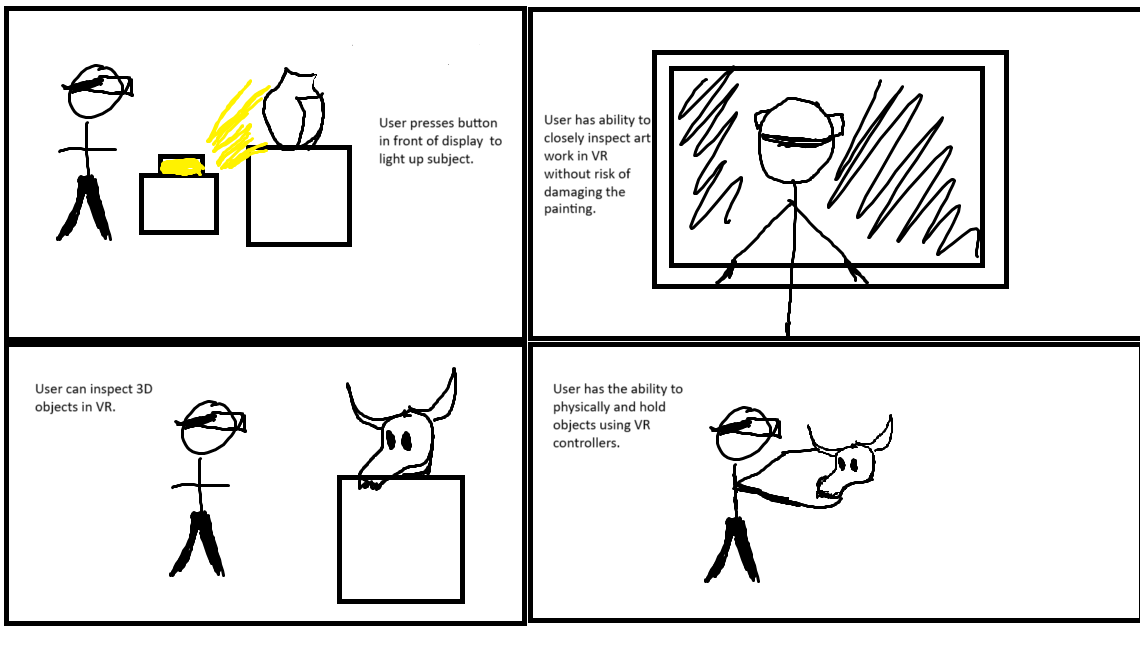KIT208 Report
Introduction / Overview:
We have created a VR Museum tour application, where the user can be immersed in the world of ancient artifacts and art. In this virtual museum, the user will have the unique opportunity to interact with three Greek vases, control lighting to enhance their viewing experience, and examine a realistic ram skull up close. Our application aims to provide an engaging and educational experience that showcases the potential of VR technology in the realm of cultural exploration and interactive learning.
Description of the Application:
The VR Museum tour application combines virtual reality technology with the rich history of ancient artifacts and art. Users can explore a single room that houses a collection of displays.
Enhanced Learning:
Our application promotes active learning by allowing users to control their exploration, encouraging them to seek out details and engage with the exhibits in a more meaningful way.
Preservation of Cultural Heritage:
By digitizing and presenting ancient artifacts in a virtual environment, we contribute to their preservation and make them accessible to people who might not have the opportunity to visit physical museums.
Significance of VR in the Context of the Application:
The choice of VR as the interface technology for our museum tour application is instrumental to its success. Here's why VR is significant:
Immersive Learning:
Virtual Reality aims “To build a visual interface that takes advantage of the architecture of the human visual system” (Furness) VR provides a level of immersion and presence that is unparalleled in digital settings. Users feel like they are physically present in the museum, enhancing their engagement and retention of information.
Interactivity:
“As well as being able to simulate explorations in virtual environments, it is possible to simulate infeasible interactions” (Perez-Valle & Sagasti, 2012; Sharma & Otunba, 2012). VR allows for natural and intuitive interactions with virtual objects that users would not normally have access to, such as controlling lighting and handling artifacts. This level of interactivity adds depth to the learning experience and encourages exploration.
Accessibility:
VR technology enables individuals from around the world to access and explore cultural heritage without physical constraints. For a student living somewhere far away, access to these relics would be difficult and time consuming, but “through VR these same students could explore the architectural brilliance of the Pantheon or even purely imaginary structures without ever leaving their classroom.” Gaitatzes et al. (2011)
Interaction Design:
Interactions are crucial in our VR museum tour application to enhance user engagement and provide a more immersive and educational experience. They serve the following purposes:
Light Control: Users can choose to manipulate the lighting in the room, allowing them to light up aspects of the vases. This feature helps personalize the users experience with the artifacts.
Ram Skull Interaction: Users can pick up and interact with a lifelike ram skull. This hands-on experience enables them to examine the details of the skull, rotate it, and gain a better understanding of the anatomy. This interaction allows the users to interact with the skull in a way they would not normally be comfortable with or have the resources.
Storyboard:

Technical Development:
Specific interface technology used: Our VR Museum tour application is designed for use with the Quest 2 VR headset. The Quest 2 offers high-quality VR experiences, including hand-tracking capabilities for intuitive interactions. The application was developed using Unity.
How to engage with available interaction(s):
- Light Control: Users can activate this interaction by looking at the light source and pressing a button on the Quest controllers. A menu appears, allowing them to adjust the light intensity or turn it on/off.
- Ram Skull Interaction: To engage with the ram skull, users simply reach out and grab it using the Quest controllers. They can then manipulate the skull, rotate it, and examine it up close by using the controllers' gestures.
Descriptions of 3D Models:
- Greek Vases:
- Purpose: These three Greek vases are replicas of historical artifacts. They serve as the central exhibits in the virtual museum, showcasing the history of ancient Greece.
- Thumbnail:
- Ram Skull:
- Purpose: The ram skull is a detailed 3D model that allows users to engage in tactile learning. Users can pick up and manipulate the skull to explore its anatomical features and gain a deeper understanding of this historical object.
- Thumbnail:
- Couch and Table:
- Purpose: The couch is for decoration to complete the room.
- Thumbnail: [Insert thumbnail image of the couch.]
References
Journals
- Promoting Knowledge Construction: A Model for Using Virtual Reality Interaction to Enhance Learning
- Authors: Yun Zhou, Shangpeng Ji, Tao Xu, Zi Wang
- Source: ScienceDirect
- URL: https://www.sciencedirect.com/science/article/pii/S1877050918303867?via%3Dihub
- Reviving the Past: Cultural Heritage meets Virtual Reality
- Author: Athanasios Gaitatzes
- Source: ResearchGate
- URL:https://www.researchgate.net/publication/2847543_Reviving_the_Past_Cultural_Heritage_Meets_Virtual_Reality
- A systematic review of Virtual Reality in education
- Authors: Sam Kavanagh, Andrew Luxton-Reilly, Burkhard Wuensche, Beryl Plimmer
- Source: Yu-Lien Chang, et al. “Apply an Augmented Reality in a Mobile Guidance to Increase Sense of Place for Heritage Places.” Journal of Educational Technology & Society, vol. 18, no. 2, 2015, pp. 166–78.
- Database: JSTOR
- URL: http://www.jstor.org/stable/jeductechsoci.18.2.166
Toward tightly-coupled human interfaces Dr. Thomas A. Furness III
3D Models:
Vases:
https://assetstore.unity.com/packages/3d/environments/historic/greek-temple-vases-149134
Textures:
https://assetstore.unity.com/packages/2d/textures-materials/floors/free-pack-woden-planks-214610
Painting:
https://assetstore.unity.com/packages/3d/props/interior/paintings-free-44185
Couch:
https://assetstore.unity.com/packages/3d/environments/lowpoly-art-deco-furniture-249606
Tutorials